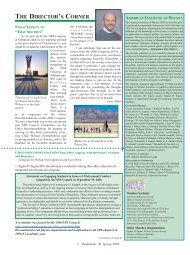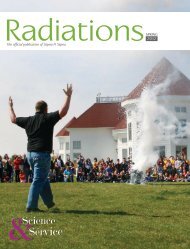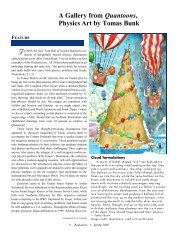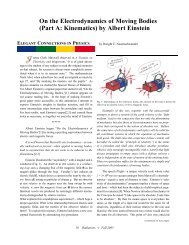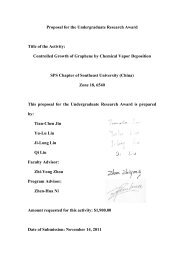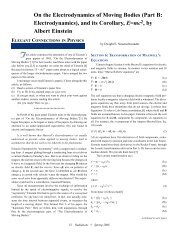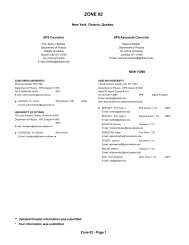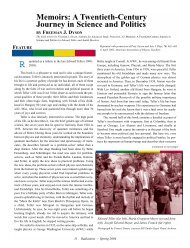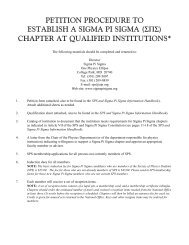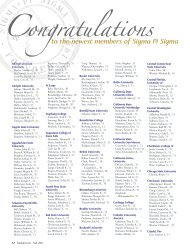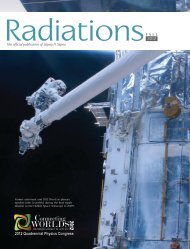History of Big Bang Cosmology, Part 4 - Sigma Pi Sigma
History of Big Bang Cosmology, Part 4 - Sigma Pi Sigma
History of Big Bang Cosmology, Part 4 - Sigma Pi Sigma
- No tags were found...
You also want an ePaper? Increase the reach of your titles
YUMPU automatically turns print PDFs into web optimized ePapers that Google loves.
m<br />
r<br />
4/3<br />
= const. (21)<br />
Using primes to denote “then” as the time <strong>of</strong> element formation<br />
in the early universe, and double primes to denote “now,” Alpher<br />
״ and Herman calculated that “the specification <strong>of</strong> m<br />
׳ , m<br />
׳ , and r<br />
״r fixes the present density <strong>of</strong> radiation, <br />
. In fact, we find that the<br />
״ value <strong>of</strong> r<br />
, consistent with Eq. (4) [our Eq. (21)], is<br />
״ r<br />
10 32 g/cm 3 ,<br />
which corresponds to a temperature now <strong>of</strong> the order <strong>of</strong> 5K.<br />
This mean temperature for the universe is to be interpreted as the<br />
background temperature which would result from the universal<br />
expansion alone.”<br />
Radiation at a temperature <strong>of</strong> a few Kelvins means that the cosmic<br />
afterglow <strong>of</strong> the big bang would exhibit a Planck spectrum<br />
peaked in the microwave part <strong>of</strong> the spectrum. Thus was the<br />
existence and temperature <strong>of</strong> the cosmic microwave background<br />
radiation (CMBR) predicted by Alpher and Herman in 1948 and<br />
1949.<br />
Throughout the balance <strong>of</strong> the 1940s and through the 1950s,<br />
they attempted to convince radio astronomers to search for<br />
this relic radiation, to no avail. However, it seems to have<br />
been detected (but not recognized as the CMBR) in the early<br />
1940s,[32] and discovered (and recognized) in the USSR in 1957.<br />
[33] Few noticed.<br />
In late 1964, A. Penzias and R. Wilson serendipitously<br />
detected an unaccounted-for 3 K temperature excess in their<br />
microwave antenna.[34] The Princeton group <strong>of</strong> R.H. Dicke,<br />
P.J.E. Peeble, P.G. Roll, and D.T. Wilkinson interpreted the discovery<br />
as a CMBR.[35] Neither one <strong>of</strong> these papers cited the<br />
CMBR prediction <strong>of</strong> Alpher and Herman, and until recent years<br />
few seemed to recall the Alpher-Herman prediction <strong>of</strong> the CMBR<br />
at all. Over the years, the error <strong>of</strong> citing Gamow or “Gamow and<br />
his students” as the original author <strong>of</strong> the CMBR prediction has<br />
been propagated.<br />
This unfortunate circumstance put Ralph Alpher and Robert<br />
Herman in the distinguished cosmological company <strong>of</strong> Alexander<br />
Friedmann and Georges Lemaître. As in their cases, the overdue<br />
record <strong>of</strong> priority is slowly being set straight.[36-39] The detection<br />
<strong>of</strong> the CMBR, whose existence was predicted by Alpher and<br />
Herman, was the cinching link between theory and evidence that<br />
compelled the astrophysics community to take the hot big bang<br />
seriously. Friedmann and Lemaítre “made the universe expand,”<br />
and Alpher and Hermann made it glow.<br />
Acknowledgments<br />
I express my deep thanks and appreciation to Victor Alpher.<br />
With gratitude I also thank Charles Misner for his generous<br />
advice given at the beginning <strong>of</strong> this multiarticle project.<br />
[1] “A Survey <strong>of</strong> <strong>Big</strong> <strong>Bang</strong> <strong>Cosmology</strong>, <strong>Part</strong> 1: Cosmic<br />
Geography,” Radiations 13, 14-18 (Fall 2007).<br />
[2] “<strong>History</strong> <strong>of</strong> <strong>Big</strong> <strong>Bang</strong> <strong>Cosmology</strong>, <strong>Part</strong> 2: The Problem with<br />
Infinity,” Radiations 14, 25-29 (Spring 2008).<br />
[3] “<strong>History</strong> <strong>of</strong> <strong>Big</strong> <strong>Bang</strong> <strong>Cosmology</strong>, <strong>Part</strong> 3: The de Sitter<br />
Universe and Redshifts,” Radiations 14, 23-27 (Fall 2008).<br />
[4] A. Einstein, 1917 “Cosmological Considerations on the<br />
General Theory <strong>of</strong> Relativity, tr. in The Principle <strong>of</strong> Relativity<br />
(Dover, 1952), pp. 177-188.<br />
[5] W. de Sitter, Proc. Roy. Acad. Sci. (Amsterdam) 19, 1217<br />
(1917); 20, 229 (1917); 20, 1309 (1917); Mon. Not. Roy. Astron.<br />
Soc. 78, 3 (1917).<br />
[6] E. Hubble, “A Relation between Distance and Radial Velocity<br />
among Extra-Galactic Nebulae,” Proc. Natl. Acad. <strong>of</strong> Sci. U.S.A.<br />
15, 168-173 (1929).<br />
[7] G.F.R. Ellis, “Innovation, Resistance and Change: The<br />
Transition to the Expanding Universe,” in Modern <strong>Cosmology</strong> in<br />
Retrospect, B. Bertotti, R. Balbinot, S. Bergia, and A. Messina,<br />
Eds., (Cambridge Univ. Pr. 1990), p. 104.<br />
[8] J.D. North, The Measure <strong>of</strong> the Universe: A <strong>History</strong> <strong>of</strong><br />
Modern <strong>Cosmology</strong> (Oxford, 1965, Dover 1990), p. 111-112.<br />
[9] A. Friedmann, “On the Curvature <strong>of</strong> Space,” Zeitschrift für<br />
Physik 10, 379 (1922).<br />
[10] A. Friedmann, “On the Possibility <strong>of</strong> a World with Constant<br />
Negative Curvature,” Zeitschrift für Physik 21, 326 (1924).<br />
[11] E.A. Tropp, V.Ya. Frenkel, and A.D. Chernin, Alexander<br />
A. Friedmann: The Man who Made the Universe Expand<br />
(Cambridge Univ. Pr., 1993).<br />
[12] A.G. Lemaître, Ann. Soc. Sci. Brux. A47, 49 (1927); “A<br />
Homogeneous Universe <strong>of</strong> Constant Mass and Increasing Radius<br />
accounting for the Radial Velocity <strong>of</strong> Extra-galactic Nebulae,”<br />
Proc. Roy. Ast. Soc. XCI 5, 483-501 (1931).<br />
[13] Ellis, ref. 7, p. 105, which gives the original references to<br />
the 1930 meeting proceedings.<br />
[14] ibid.<br />
[15] Quoted in P.J.E. Peebles, Principles <strong>of</strong> Physical <strong>Cosmology</strong><br />
(Princeton Univer. Pr., 1993), p. 80.<br />
[16] C. Misner, K. Thorne, and J. Wheeler, Gravitation (Freeman,<br />
1972), Ch. 27<br />
[17] E.g., G. Gamow and E. Teller, “Energy Production in Red<br />
Giants,” Phys. Rev. 55, 791 (1955).<br />
[18] Tropp, Frenkel, Chernin, ref. 11, p. 158.<br />
[19] E.g., Misner, Thorne, Wheeler, ref. 16, pp. 704-710.<br />
[20] Quoted in G. Gamow, The Creation <strong>of</strong> the Universe<br />
(Viking, 1961), p. 53.<br />
[21] B. Eskridge and D.E. Neuenschwander, “A Pedagogical<br />
Model <strong>of</strong> Primordial Helium Synthesis,” Am. J. Phys. 64, 1517-<br />
1524 (1996).<br />
[22] S. Chandrasekhar and L.R. Henrich, “An Attempt to Interpret<br />
the Relative Abundances <strong>of</strong> the Elements and Their Isotopes,”<br />
Ast. J. 9, 288-298 (1942).<br />
[23] G. Gamow, “Concerning the Origin <strong>of</strong> Chemical Elements,”<br />
J. Wash. Acad. Sci. 32, 353-373 (1942); “Expanding Universe and<br />
the Origin <strong>of</strong> Elements,” Phys. Rev. 70, 572-573 (1946).<br />
[24] Alpher had almost completed a dissertation on galaxy formation<br />
when he was “scooped” by E. Lifchitz. See the biographical<br />
article by Victor Alpher that begins on p. 15 <strong>of</strong> this issue <strong>of</strong><br />
Radiations.<br />
[25] R.A. Alpher, H. Bethe, and G. Gamow, “The Origin <strong>of</strong><br />
Chemical Elements,” Phys. Rev. 73, 803-804 (1948).<br />
[26] R. Alpher, “A Neutron-Capture Theory <strong>of</strong> the Formation and<br />
Relative Abundance <strong>of</strong> the Elements,” Phys. Rev. 74, 1577-1589<br />
(1948).<br />
24 Radiations Spring 2009



